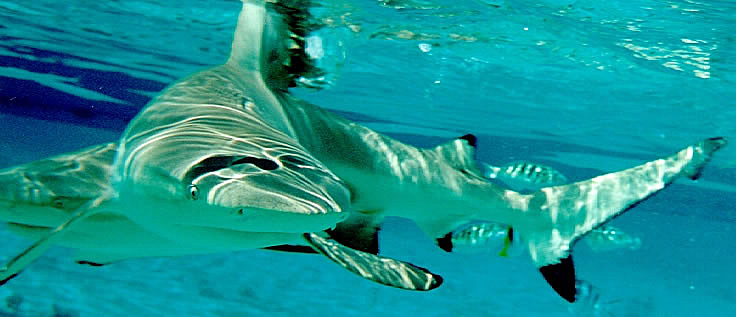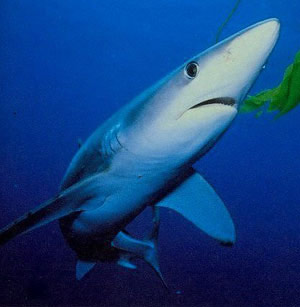|
 Bull Shark
Bull Shark
 Great White
Great White
 Mako Shark
Mako Shark
 Tiger Shark
Tiger Shark
 Blue Shark
Blue Shark
 Hammer Head
Hammer Head
|
  
~MONSTERS OF THE DEEP~
.Click links to the left to learn more about these oceanic Titans.
Sharks are among the world's most successful groups of animals, inhabiting the seas for more than 400 million years. And for more that 100 million years, they have been nearly unchanged in form. Together with their closest relatives, the skates, rays, and sawfishes, they are collectively known as elasmobranchs.
Altogether, there are about 400 species of sharks. All have certain anatomical features in common, most notably the fact that their skeletons are made entirely of cartilage as contrasted to the bony fishes whose skeletons contain true bone. Sharks are different in other ways, too. They have the same five senses we have plus electrosensitivity which helps them find live prey that may be hidden. Also, unlike most bony fishes, sharks do not have wel-developed ribs or a swim bladder. Thus, sharks are slightly negatively buoyant. And despite the lift from a large oil-rich liver, they sink slowly unless they continue to swim. Typically, there are from five to seven pairs of gill slits on the head through which water exits after having entered through the mouth or spiracles (small holes on top of the head in some species) and having passed over the gills which extract oxygen.
Like higher animals, sharks reproduce by internal fertilization. The male is equipped with a pair of claspers although he may use only one at a time. The female is also doubly equipped in that she has two uterine horns. When mating takes place, the male may clamp his jaws onto one of the female's pectoral fins as a way of immobilizing her. The female who has bred often will also bear mating bite marks elsewhere on her body.
As for the manner of reproduction, about 40% of shark species are oviparous, i.e. egg layers, and 60% are live-bearers, being either aplacental or placental viviparous. The egg layers, like some of the dogfishes, encapsulate the embryo attached to its nutritive yolk sac in a horny casing to protect it. When this food is exhausted, the young shark hatches and swims free to fend for itself in a more dangerous world.
The deep sea holds many species in surprising forms and about which relatively little is known. There is one shark that is fully grown at only six inches, and another dubbed the "cookie cutter" for its round mouth with large wedge-shaped teeth on the bottom jaw used to carve out plugs of meat from large fishes and marine mammals. The eyes in these deep water sharks are often emerald green and adapted to perceive the luminescence of other animals that also dwell where sunlight never reaches. All sharks can be considered flesh eaters although a few feed like baleen whales, filtering the water for plankton and small fish. The degree of specialization in feeding is indicated by the shape and size of a shark's teeth. Thin, pointed teeth, as in the mako shark, are for grabbing and holding prey; serrated, wedge-shaped teeth for cutting out big mouthfuls are found in the white shark; small conical teeth help the nurse shark crush invertebrates which are important in its diet.
|